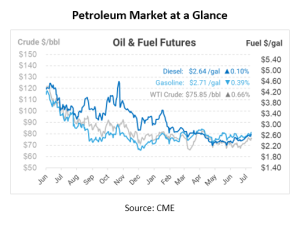
How much time are you wasting on fuel inventories?
How much time is your business spending on managing fuel inventories? While it may not seem like much, the odds are that the minutes and hours are adding up quickly. Why should your site personnel – who are busy serving customers – have to touch fuel anyways?
Depending on how your fuel tanks are set up, the process may be quick and easy – or it could be long and painful. Years ago, it was the norm for site personnel to “stick the tank” – go outside each day with a long-measured stick, drop it down into the tank, and then measure the inches of fuel in the tank. That inch measurement was then converted to an inventory reading based on the tank’s dimensions. Let’s say that takes 20 minutes – if you have 20 sites, doing this 5x per week, then your company is spending 33 hours per week just taking measurements. That’s almost a full-time job!
Today, that process has been eliminated for many locations with an automatic tank gauge (ATG) – though some sites still have personnel sticking the tank regularly. ATGs are probes that float with the fuel and send back a precise gallon inventory amount. But this still requires that someone monitor those readings online or on a physical device. And if sites spend 10 minutes on that daily, that’s still almost an hour per week of lost time and productivity. And that doesn’t even cover the time spent ordering fuel, tracking it, and validating it after the fact.
It’s time to take control and optimize your fuel management strategy. Efficient fuel inventory management is an important success factor for businesses in transportation, manufacturing, construction, and many other industries. You want to keep carrying costs low while ensuring you always have enough fuel on hand to stay operational.
Fuel inventory management goes beyond basic tracking. It’s a strategic process that empowers businesses to effectively manage fuel stocks, usage, and ordering. By gaining real-time insights into fuel inventory levels and consumption patterns, you can make better decisions, reduce costs, and avoid fuel shortages. In today’s article, we’ll explore some of the best practices for fuel management that will transform your business.
Why Fuel Inventory Management Matters
Fuel is a significant expense for businesses, and effective inventory management is the secret to minimizing costs and boosting your bottom line. It ensures companies have the right amount of fuel on hand to meet operational needs while avoiding unnecessary expenses and cash flow challenges. But that’s not all.
A successful fuel inventory management strategy brings a wide range of benefits. It allows companies to keep a steady fuel supply, mitigating the chance of service disruptions and transportation delays. By closely monitoring fuel consumption patterns, organizations can detect and prevent theft, fraud, or leaks, ensuring the preservation of valuable fuel resources. Additionally, accurate tracking of fuel consumption and emissions helps businesses stay compliant with
environmental regulations, highlighting their commitment to sustainability. It is also important to mention that an efficient strategy enables the identification and resolution of inefficiencies in fuel usage, leading to cost savings and optimized overall fuel efficiency.
How to Automate Your Inventory Management
Your site personnel should be focused on serving their customer, not wasting time managing fuel levels! That’s where inventory management comes in. For a low monthly fee, your fuel supplier can manage your inventories on your behalf, saving your sites time and efforts. That means more time spent helping customers, and less time spent on unnecessary details.
As an example, Mansfield’s Inventory Management team looks at thousands of tanks each day to check current inventory levels, typical consumption patterns, and determine the days of inventory. Based on the customer’s preference, inventories can be managed “from the top” – to ensure the tank is always full and prevent outages – or “from the bottom” to minimize carrying costs. These experts stay apprised of local supply conditions, adverse weather events, and more to make sure each delivery is placed with enough lead time to keep the customer running.
If you’re not confident that each of your locations is ordering fuel strategically and efficiently, perhaps it’s time to try outsourcing your inventory management. You can even pilot this program at a few sites before rolling it out company-wide.
Contact Mansfield
Want to find out if inventory management solutions are right for your business? Contact a Mansfield expert to pilot the program and see how easy it is to automate your fuel program.

This article is part of Daily Market News & Insights
Tagged:
MARKET CONDITION REPORT - DISCLAIMER
The information contained herein is derived from sources believed to be reliable; however, this information is not guaranteed as to its accuracy or completeness. Furthermore, no responsibility is assumed for use of this material and no express or implied warranties or guarantees are made. This material and any view or comment expressed herein are provided for informational purposes only and should not be construed in any way as an inducement or recommendation to buy or sell products, commodity futures or options contracts.





